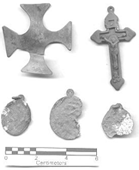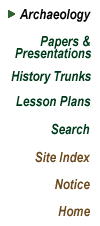

 |
 |

|
The decaying ruins of a once bustling coal mining community called Berwind
litter a stretch of narrow canyon, less than three miles from the site
of the Ludlow Massacre. The people who participated in the 1913-14 Strike
lived and labored in Berwind and dozens of other mining camps like it.
The remains of homes, schools, administrative offices, and industrial
equipment run along the sides of Berwind Canyon Road for over a mile.
As part of this project, some of the things we are interested in is how
people lived in the coal camps, how these conditions led to the strike,
and how conditions changed as a result of the strike. To answer these
questions we needed to locate archaeological deposits at Berwind that
dated to before and after the strike. Figure 1: We surveyed and mapped the entire town area, recording each feature,
such as foundations, walls, etc. (Figure 1) We discovered
a number of geographically distinct areas, including areas associated
with different classes and ethnic groups. After completing the map, we
conducted a surface collection of those artifacts that can be dated firmly
from each area in order to trace the development of the community over
time and to determine if certain areas were occupied before the strike,
and if others were occupied after the strike. We walked over each area
scanning the surface for artifact scatters, specifically those with temporal
markers such as colored glass, tin can types, electrical accoutrements
and container closures that would allow us to narrow the date of occupation
in each area. Our analysis suggests that there is at least one area that
was occupied previous to the strike and appears to have been abandoned
shortly thereafter. This is particularly significant given the fact that
Berwind was a densely occupied and growing community, doubling in population
after the strike. Nearly every inch of space that was habitable was occupied. Over the years, we have had a lot of interest in the archaeology at
Ludlow and Berwind. In addition to talks and tours given to visitors to
the monument, we had a number of more formal presentations at clubs as
well as archaeological conferences. These include: 4-H Club, Trinidad
Historical Society, the Pike's Peak Chapter of the Colorado Archaeological
Society, and AFL-CIO Union Summer interns. Each year one of the Principle
investigators speak at the Memorial Service and explain what the project
is up to and how the projects activities increase public awareness of
events like the Ludlow Massacre. We are currently concentrating on lab analysis of previous field season’s materials and are not planning to return to the field for the 2003 field season. |
| Home | Notice | Site Index | DU Anthro Home |